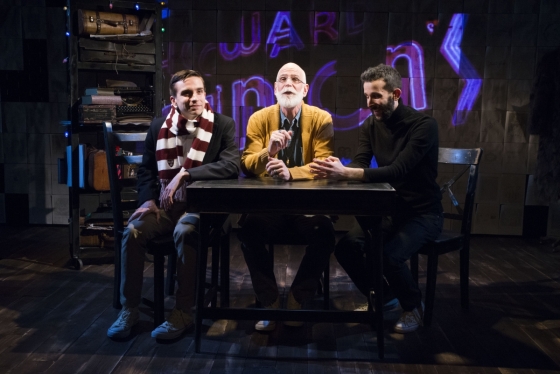
If you’ve ever watched the opening of the long-running PBS anthology series Mystery!, then you’ve seen the art of Edward Gorey. If you haven’t, well, he is not the most mainstream of artists, though perhaps the mainstream has edged closer to his sensibility in our post-Tim Burton, post-Hot Topic world. Gorey: The Secret Lives of Edward Gorey, a new play by Travis Russ, does not walk the audience through Gorey’s greatest hits in common biographical narrative fashion (so if you are unfamiliar with his work, do yourself a favor and look into it on your own). In fact, in this play, Gorey refers to his most famous work, The Gashlycrumb Tinies, with clear weariness. Instead, Gorey quickly asserts that time is "fragile, fleeting, and fluid," and takes that idea as its structuring principle. Andrew Dawson, Aidan Sank, and Phil Gillen share the stage as younger, mature, and older versions of the artist, a compression of Gorey’s life that derives poignancy from its multiple perspectives and voices, such as when the youngest Gorey cheerfully says that the move to the Cape Cod house that he and his cats would occupy until his death is only temporary. Gorey was something of a collector, to put it mildly, and the contents of his house, catalogued by volunteers after his death, provide the other structuring principle in the play, with items often triggering memories or enactments of various points in his life.
The set reproduces the atmosphere of Gorey's house -- we’ve been there, we know! -- and the major features, aside from a desk holding a phonograph and a tailor’s form to hold his trademark fur coat, are shelves crammed with his collected items, many stored in a variety of suitcases. The entire back wall is covered in 8 ½" by 11" Gorey images, representing the thousands of pages found in his home after his death, and which the audience is encouraged to go onstage and examine before the show begins. These images also serve as a screen for various projections, including footage of his home and of rejection letters, as well as an animated appearance by “doubt,” better known as The Doubtful Guest and often regarded as a self-portrait (an interpretation that the play cleverly offers another angle on). Doubt and liminality, particularly artistic and romantic, emerge as themes here. Idiosyncrasy can be problematic when the dominant social impetus is towards labels and explanations and discourages kitsch and quirk. (Not many people besides Gorey, for example, would call George Balanchine’s commercially disastrous Pan-Am-themed ballet fabulous.) This problem applies as much to his work, which he says he is sick of hearing called morbid and which he feels that explanation diminishes, as to his personal life, for which he refuses the label of “homosexual” in favor of "unclassifiable." Gorey argues, in fact, that his self and his art are separate, but how convincing that argument is is questionable.
Gorey recalls that his friend the poet Frank O'Hara wanted everyone to be "strange and fabulous,"and Gorey captures both of those aspects of its subject, right down to the puppet of an Abyssinian cat that played Madame Butterfly in his community theater reconceptualization. But Russ’s play, using a combination of Gorey's own words and the playwright’s reimagining, also fills in the complexities and contradictions, the yearning, loss, and humanity, contained in the space between "strange" and "fabulous." All three actors are excellent separately and together, and play their "Teds" as discrete parts of a whole, producing a touching production that is charming, warm, and at times melancholy. Russ acknowledges in the program that Gorey might not quite approve of this tribute to his life and work, but Gorey fans, from the casual to the diehard, will enjoy this vision of a life and its art. - Leah Richards & John Ziegler
